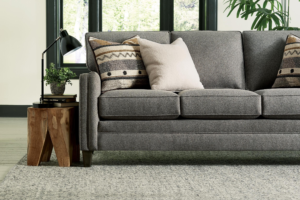Choosing the Right Sofa Fabric: A Comprehensive Guide
Selecting the perfect fabric for your sofa is an essential step in ensuring it meets your style, durability, and comfort needs. Sofas are significant investments, and the right fabric can enhance their aesthetic appeal, functionality, and lifespan. To make an informed choice, consider factors such as your lifestyle, the sofa’s intended use, and the environment in which it will be placed. Here’s a detailed guide on how to choose the right fabric and what to look out for.
Factors to Consider When Choosing Sofa Fabric
1. Lifestyle and Household Needs
Your household dynamics heavily influence the type of fabric best suited for your sofa.
- Children: If you have young children, opt for fabrics that are stain-resistant and easy to clean, such as microfiber or performance fabrics like Crypton.
- Pets: For households with pets, choose materials that resist scratching, fur accumulation, and stains, such as leather or olefin. Avoid loosely woven fabrics that claws can snag.
- Allergies: Hypoallergenic fabrics like microfiber are ideal for reducing the accumulation of allergens like dust and pet dander.
2. Durability
Durability is critical, especially for high-traffic furniture. The durability of a fabric is often measured by its double rub count, a test that determines how much wear and tear a material can handle.
- For Decorative Use: Light-use fabrics with a double rub count of 10,000–15,000 are suitable.
- For Moderate Use: Medium-duty fabrics with 15,000–25,000 double rubs are better for family rooms or occasional use sofas.
- For Heavy Use: High-duty fabrics with 25,000+ double rubs are designed for sofas that will see daily use in busy households.
What to Look Out For:
- Tightly woven fabrics last longer and resist pilling.
- Performance fabrics like Sunbrella or Crypton offer exceptional durability, stain resistance, and moisture protection.
3. Comfort
The feel of a fabric is just as important as its durability. Consider how you want the sofa to feel during use.
- Soft Fabrics: Velvet, chenille, and microfiber provide plush comfort and are ideal for cozy, lounge-worthy sofas.
- Breathable Fabrics: Cotton, linen, and wool are more breathable and comfortable in warm climates.
- Cool or Smooth Fabrics: Leather and faux leather provide a sleek, polished feel, though they may require temperature control for year-round comfort.
What to Look Out For:
- Sit on the sofa or feel fabric swatches before purchasing to ensure it meets your tactile preferences.
- Ensure the fabric aligns with the sofa’s purpose—formal versus casual lounging.
4. Aesthetics and Style
The fabric you choose significantly affects your sofa’s overall look and how it complements your decor.
- Colors: Neutral tones like beige, gray, and cream are timeless and versatile, while bold colors like navy or mustard make a statement.
- Patterns: Geometric or floral patterns add personality, but they may become dated over time. Solid colors are easier to match with changing decor.
- Textures: Smooth fabrics like leather or flat-woven polyester fit minimalist or modern styles. Textured fabrics like bouclé or tweed add warmth and dimension for traditional or cozy interiors.
What to Look Out For:
- Ensure colors and patterns match the room’s overall color scheme.
- If your sofa is a focal point, consider vibrant or textured fabrics to draw attention.
5. Maintenance Requirements
Different fabrics come with varying care needs. Some are easy to clean, while others require professional attention.
- Low-Maintenance Fabrics: Microfiber, polyester blends, and performance fabrics resist stains and can often be cleaned with water or mild detergents.
- High-Maintenance Fabrics: Linen, silk, and some natural fibers may require professional cleaning and are more prone to staining.
- Removable Slipcovers: Fabrics with removable covers are practical for easy washing, especially for families and pet owners.
What to Look Out For:
- Check the fabric’s cleaning instructions. Some materials are machine washable, while others require spot-cleaning or dry-cleaning.
- Consider protective treatments for natural fabrics to enhance their stain resistance.
6. Environmental Factors
The placement of your sofa affects the fabric’s longevity. Consider environmental influences like sunlight, humidity, and temperature.
- Sunlight Exposure: Fabrics like cotton and silk fade quickly in direct sunlight. Opt for UV-resistant fabrics like Sunbrella if the sofa will be in a sunny area.
- Humidity and Moisture: Moisture-resistant fabrics like olefin or treated polyester are better suited for humid climates or homes near water.
What to Look Out For:
- If sunlight exposure is unavoidable, use window treatments to protect the sofa.
- Avoid delicate fabrics in areas prone to spills or dampness.
7. Budget
Fabric type often correlates with cost, so it’s essential to align your choice with your budget.
- Affordable Options: Polyester, microfiber, and some cotton blends offer great durability and style at a lower cost.
- Mid-Range Options: Leather alternatives (e.g., faux leather) and performance fabrics provide a balance of quality and affordability.
- High-End Fabrics: Genuine leather, velvet, and wool are luxurious but come with a higher price tag.
What to Look Out For:
- Balance cost with longevity. Investing in a more durable fabric may save money in the long run.
Common Upholstery Fabrics and Their Characteristics
Here’s a breakdown of popular upholstery fabrics to help you compare and choose:
- Leather: Durable, luxurious, and easy to clean but expensive and temperature-sensitive.
- Microfiber: Soft, stain-resistant, and budget-friendly, ideal for pet- and kid-friendly homes.
- Velvet: Plush and elegant but can show marks from pressure and needs regular brushing.
- Linen: Breathable and sophisticated but prone to wrinkles and stains, requiring professional cleaning.
- Polyester Blends: Affordable, durable, and available in a variety of textures and patterns.
- Performance Fabrics: Treated to resist stains, fading, and moisture, perfect for busy households.
- Cotton Blends: Comfortable and breathable, often blended with synthetics for improved durability.
Key Questions to Ask When Choosing Sofa Fabric
- How will the sofa be used? Casual lounging, formal decor, or daily seating?
- Who will use the sofa? Adults, children, pets, or a combination?
- What is the environmental exposure? Sunlight, humidity, or heavy wear?
- What are the care requirements? Will you have time to maintain high-maintenance fabrics?
- Does the fabric suit the room’s decor? Does it match the style, color, and texture of your space?
Conclusion
Choosing the right sofa fabric involves balancing durability, comfort, style, and maintenance. Consider your household needs and environment to find a material that aligns with your lifestyle. Whether you prioritize the practicality of performance fabrics, the sophistication of velvet, or the timeless appeal of leather, understanding these factors will help you make a confident decision. A well-chosen sofa fabric ensures your investment remains functional, beautiful, and inviting for years to come.











